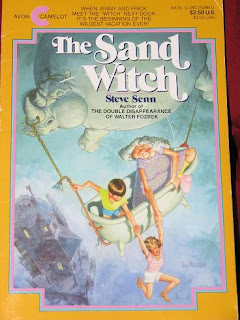Oscar Senn (AKA Steve Senn, Oscar Steven Senn, Steve Oscar Senn, etc…) as he is known to his friends and family, is best known as an author (mostly as "Steve Senn") and artist (as "Oscar Senn"). He was born in Americus, Georgia in 1950 and was raised in Dawson. He went to school at the Ringling School of Art in Sarasota, Florida. He worked for The Florida Times-Union and the Miami Herald newspapers as an illustrator (I’d love to see these). He also worked as an Art Director in Jacksonville, Florida. He moved to Los Angeles, California for a while where he was also an Art Director, and I believe he currently resides in Jacksonville, Florida again.
Being a "book" blog, I will be mostly focusing on Oscar/Steve's books. ha ha.
His first book, writing as Steve Senn, was
The Double Disappearance of Walter Fozbek (Hastings House, 1980) and it is one of his best known books. I have a blog that will be posted later about it on here. It is about a boy who wakes up in a different universe that is exactly like his own… except everything that was Human is now Dinosaur. The book was released in paperback format from Avon/Camelot five years later (1985). Later that same year, there was an animated CBS Storybreak episode of it. Mr. Senn illustrated the cover (of the hardcover version) and the book itself. The paperback’s cover looks like it was done by Tom Newsom (one the GREAT unsung heroes of the illustrator world; if you have a lot of kid’s paperbacks from the 80’s you probably have some of Mr. Newsom’s work… or even if you have some Celestial Seasoning’s boxes in your cupboard!).
Next came Mr. Senn’s books for young Science Fiction / Fantasy readers, the
Spacebread series of books;
Spacebread (Atheneum, 1981) and
Born of Flame: A Spacebread Story (Atheneum, 1982). They are about a swashbuckling interstellar cat named Spacebread and her adventures in the universe. These books are Sci-fi/Fantasy for young adults, and kids should eat ‘em up… if you can find them. The covers were painted by the author, and the first book, Spacebread, is illustrated Mr. Senn too. The character of Spacebread is based on a real Persian kitty that Mr. Senn had for several years in the mid-seventies. As far as I know, the two Spacebread books have only been available in hardcover.
A Circle in the Sea (Atheneum, 1981) came next. This book is hard to find at an affordable price, but the story is excellent. I just interlibrary loaned it because I finally gave up the search. Stupidly, I didn’t write down the copyright info before I gave it back! I believe it is so hard to find because so many who have read it LOVE it so much. The author told me that this book is his “best stuff in print.” It is about a girl who receives an ancient ring that gives her the power to transfer her essence/mind into the body of a dolphin named Breee. An “adaptation” of this book was reprinted in a textbook called
Blueprints by Virginia A. Arnold and Carl B. Smith (Macmillan Publishing Company, 1989; part of the Macmillan Connection Reading Program) under the title “A Gift From the Sea” (which is the title of one of the chapters of the book).
I compared these a bit when I had
A Circle in the Sea from the library. The 20 page “adaptation” is very short and it cuts out some of the scarier elements (like how the ring was still attached to a finger!), and it is newly illustrated by Warren Chang. The original hardcover’s dust-jacket was painted by Mr. Senn and it is beautiful. I believe
A Circle in the Sea was released only as a hardcover.
Next:
In the Castle of the Bear (Atheneum, 1985). This is a tale that can capture many imaginations and possibly even disturb you a bit too. It is about a young boy, Jason, who secretly writes poetry and how he deals with his inner demons including his mother’s death and a possible witch named Lauren who also happens to be his new stepmother. As a “child of divorce” I can see how this book could really effect and fascinate some readers, but I’ve always had loving step-parents (yeah… more than one) that I’ve never had ill-feelings about (but I also didn’t have a parent die first). Jason’s emotions are strong, and Mr. Senn conveys them in his words very well. The front of the dust-jacket is painted by Mr. Senn, and the back of the dust-jacket has an illustration featuring “the Bear” also drawn by Mr. Senn. Also, if you have this book, take off the dust jacket and look at the beautiful copper colored foil-stamping on the book cover. Nice. I believe this was released only in hardcover.

After that comes a sequel (well, sort-of) to
Double Disappearance called:
Ralph Fozbek and the Amazing Black Hole Patrol (Avon Camelot, 1986). If you’ve read
Double Disappearance, you will recognize some of the characters (like Dr. Krebnickel and Ralph himself who were both in
Double Disappearance!). Mr. Senn illustrated the book, and Tom Newsome did the cover of the paperback (no hardcover was released as far as I know). This book also features Loonie Louie Fabmyer who got his own book in this series in 1991. Also in this book, the town gets a name “Fogville” (I really don’t remember it getting mentioned in the first book), because of the name of the town and the changing main characters, this could be called
The Fogville Series. Mr. Senn’s illustration style choice changed a bit in this book.
The next book by Steve Senn is
The Sand Witch (Avon Camelot, 1987). The title, an obvious pun, tells us that there is a witch in this book… and she lives on the beach. Running in at less than 100 pages, this book is a quick read. Don’t let the silly title stop you, this book is a fun jaunt. Two kids, Frick and Jenny (yes, I said “Frick”…odd name) become obsessed over the possibility that their neighbor is a witch, but that is only the beginning of this story. The Science-Fiction twist in this book really thrilled me as a younger reader. Again, Steve Senn’s inner illustration style choice changed; this time they remind me of Ron Barrett’s style). Tom Newsom’s cover painting is very fun, and it also is based on a couple of Mr. Senn’s inner illustrations. Paperback only.
Steve Senn’s last published book for children was another
Fogville book,
Loonie Louie Meets the Space Fungus (Avon Camelot, 1991) which was written under the name Oscar Steven Senn. Because of the name change, I totally missed this book growing up. Okay, that was a lie, I was too busy reading Piers Anthony and Christopher Pike to notice a “kid’s book.” I didn’t realize this book existed when I first started researching Steve Senn in 2009. It is the second sequel (so to speak) of
The Double Disappearance of Walter Fozbek. The cover is illustrated by Tom Newsom again, but this time, sadly, Mr. Senn did not illustrate the book at all (which may have been a budgetary choice made by Avon Camelot). Paperback only.


In September 2010, Oscar Senn had an art exhibit called The Hard Time Saints. In collaboration with this event Hedgehog Books released a very limited dust-jacketed hardcover called The Hard Time Saints: Miraculous New Work by Oscar Senn. It is about 20 pages and is filled with the art that was displayed and his own thoughts on each piece. The idea behind these paintings originated in the Catholic Holy Cards, but these are more “common saints.” Oscar Senn’s write-ups are awe-filling and the artwork will enthrall you. He even includes the “cast-off” black and white pictures (purchased at flea markets mostly) that some of the paintings are based on. I bought my copy directly from Mr. Senn (and he signed it “For Robert – Blessings from a weird universe”). If you go to his website and contact him, he may have others left for sale or you can order it from
the blurb website. Hardcover only.
Here are the names of some of Osacr Senn’s award winning but uncollected and possibly unpublished stories: “The Blood of Eden” (2003), “The Unexpected Guest” (2006, AKA “An Unexpected Guest” available on his website), “The Wall” (2002) and “Squeeby Rolic” (2006, available on his website).
Since his last children’s book, Oscar Senn has been mostly making a name for himself in the art world. His paintings are things of beauty! Many of his paintings feature the world from a child’s perspective and point of view. His turtle ones alone could easily make an award winning children’s book (he has had many turtle pets). He is represented in Los Angeles by
Couturier Gallery on La Brea. In Florida he is represented by Fairfax Gallery in Ponte Vedra. He was featured in Fresco Fine Art Publications’ 2008 book
Picturing Florida : From the First Coast to the Space Coast by KahrenJones Arbitman and Susan Gallo, Edition 3 of
The Artful Home: The GUILD Sourcebook of Residential Art (2005, GUILD LLC). Every once in awhile, you will run into a spot illustration in a book like his small illustrations for
The Alphabet that Changed the World: How Genesis Preserves a Science of Conciousness in Geometry and Gesture by Stan Tenen (North Atlantic Books, 2011). He even wrote a chapter in Donna Hicken’s book
The Good Fight (Closet Publishing, 2004).
Pathways to Awareness: How to Chart Your Own Spiritual Freedom (Hedgehog Books/Mystic Books, 2005) by David Keel featured Oscar Senn’s layout and design (and he may have done the cover art).
Surprisingly, you may also run into his stuff on your child’s toy shelf (or a fellow cubical dweller’s shelf in the case of his Pet Peeves plush stuffed animals or his Star Wars and Star Trek designs!).
Let me put it this way… Oscar Senn does Design Work (like Logo Design and Toy Design), Fine Art Painting, fiction writing, illustrates, and probably a million other things. Talent ooooooozes from this man’s pores! Give his books a try (or give them to your kids to try). Give his art a gander (I’d buy some if I could). I hope to see more from him in the future. Go to his website and check out more info:
http://www.originalsenn.com/
PS: Mr. Senn, if you’re reading this, please give the possibility of e-publishing your out-of-print books a deep thought or two.
PPS: He even illustrated the Stephen King/Peter Straub dust-jacket for the French hardcover edition of The Talisman, called
Le Talisman Des Territoires:

































